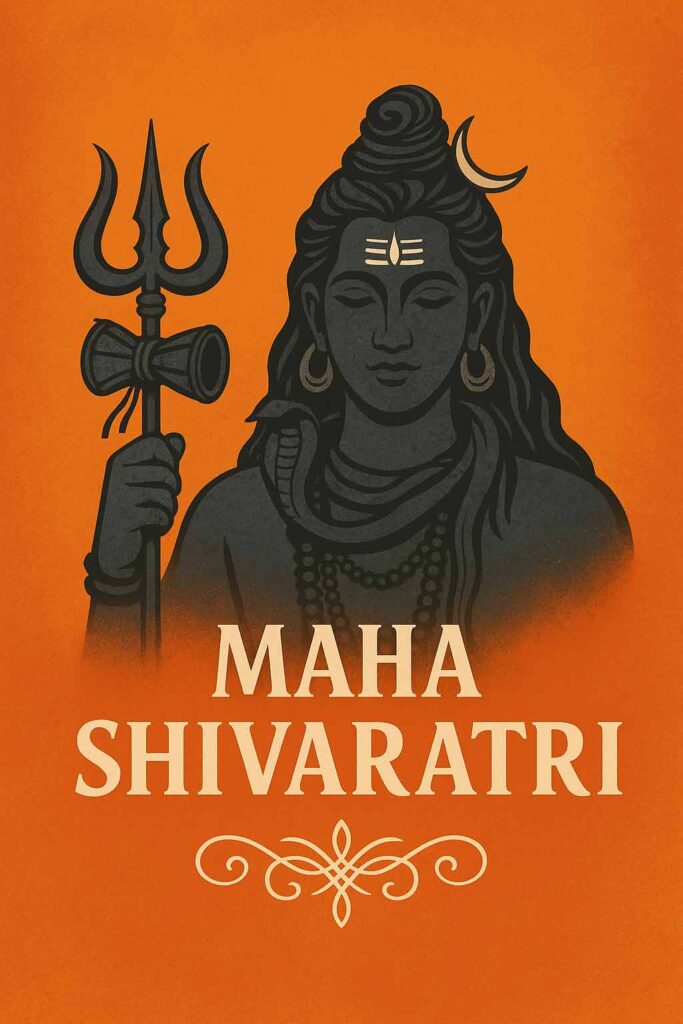Maha Shivratri (February–March)
The Night of Lord Shiva’s Cosmic Dance

Maha Shivratri, one of the most sacred festivals in Hinduism, is a grand celebration dedicated to Lord Shiva, the destroyer and transformer in the holy trinity of Brahma, Vishnu, and Mahesh (Shiva). The term “Maha Shivratri” means “The Great Night of Shiva,” and it falls on the 14th night of the dark fortnight in the Hindu month of Phalguna or Maagha (February–March). On this auspicious night, devotees stay awake in reverence and devotion to Lord Shiva, observing fasts, performing rituals, and meditating deeply to attain spiritual growth and divine blessings. Maha Shivratri symbolizes the convergence of Shiva and Shakti—the masculine and feminine cosmic energies that sustain the universe. It is believed to be the night when Lord Shiva performed the Tandava, the cosmic dance of creation, preservation, and destruction, marking the eternal rhythm of life and the universe.
The festival holds deep philosophical, spiritual, and mythological significance. According to one legend, Maha Shivratri marks the day when Lord Shiva married Goddess Parvati. Their divine union represents the balance between strength and compassion, austerity and grace. Another belief states that it was on this night that Lord Shiva consumed the deadly poison Halahala that emerged during the churning of the ocean (Samudra Manthan) to save the universe from destruction. The poison turned his throat blue, earning him the name Neelkanth—the blue-throated one. For ascetics and yogis, Maha Shivratri is not merely a festival but a spiritual opportunity to overcome ignorance, conquer desires, and experience inner peace through meditation and devotion to Lord Shiva, the Mahadeva—the great god who resides in Mount Kailash in deep meditation.
Across India and in many parts of the world, Maha Shivratri is celebrated with immense enthusiasm and devotion. Temples dedicated to Lord Shiva are beautifully decorated, and devotees throng from early morning to offer their prayers. The day begins with ritualistic bathing of Shiva Lingams—symbols of the formless divine energy—with milk, honey, water, ghee, sugar, and curd, known collectively as the Panchamrit Abhishek. Offerings of bael (bilva) leaves, dhatura flowers, fruits, and incense are made to please the Lord. Chanting of the Mahamrityunjaya Mantra and “Om Namah Shivaya” echoes through temples and homes, filling the atmosphere with spiritual vibrations. Many devotees observe strict fasts—some abstaining from food and water entirely—while others partake only in fruits and milk. The night-long vigil, known as Jagaran, is marked by devotional songs, bhajans, and recitations of Shiva scriptures like the Shiva Purana. The four prahars (quarters) of the night each carry specific rituals, representing different stages of human consciousness leading to ultimate awakening.
Maha Shivratri also carries a profound yogic and scientific significance. According to yogic traditions, on this night, the natural energy of the planet rises to its peak. It is said that keeping the spine erect during meditation or vigil allows this energy to flow upward, promoting inner balance and spiritual awakening. This is why devotees stay awake all night, chanting and meditating, aligning their energies with the cosmic vibrations of Shiva. The night symbolizes the triumph of light over darkness and ignorance, guiding devotees toward self-realization and unity with the divine.
Beyond its religious dimension, Maha Shivratri is a festival that unites people across communities. It teaches detachment, humility, and faith in divine order. It reminds humanity that life is transient and that true liberation lies in surrendering one’s ego to the higher self. As dawn breaks after the night of fasting and devotion, devotees feel renewed—a sense of calm, purity, and divine connection fills their hearts. The fragrance of incense, the resonant sound of conch shells, and the rhythmic chants of “Har Har Mahadev” echo through temples and homes, symbolizing the presence of Shiva in every particle of creation. Maha Shivratri thus stands as a timeless reminder of Lord Shiva’s cosmic dance—an eternal rhythm that sustains the cycle of life, death, and rebirth—and inspires devotees to seek truth, discipline, and ultimate freedom.
